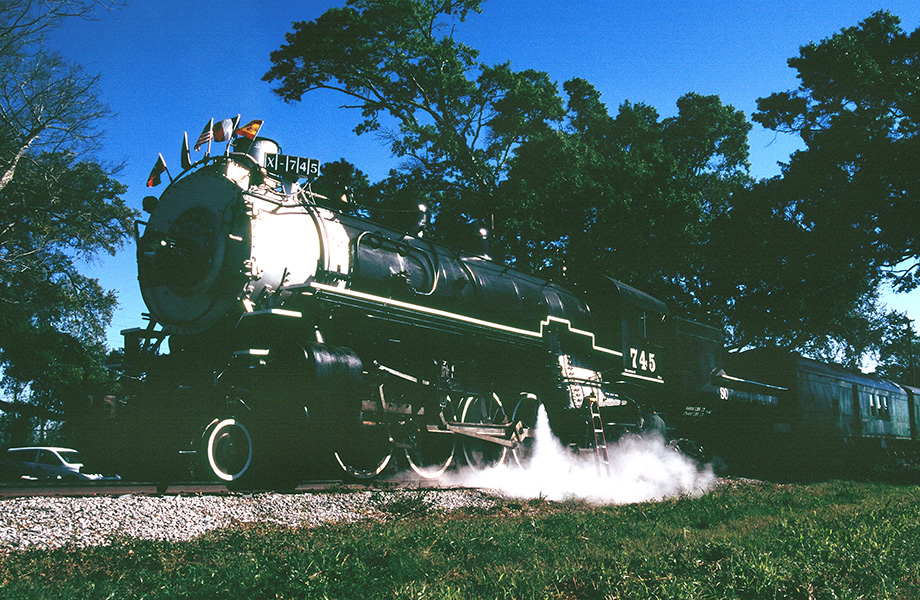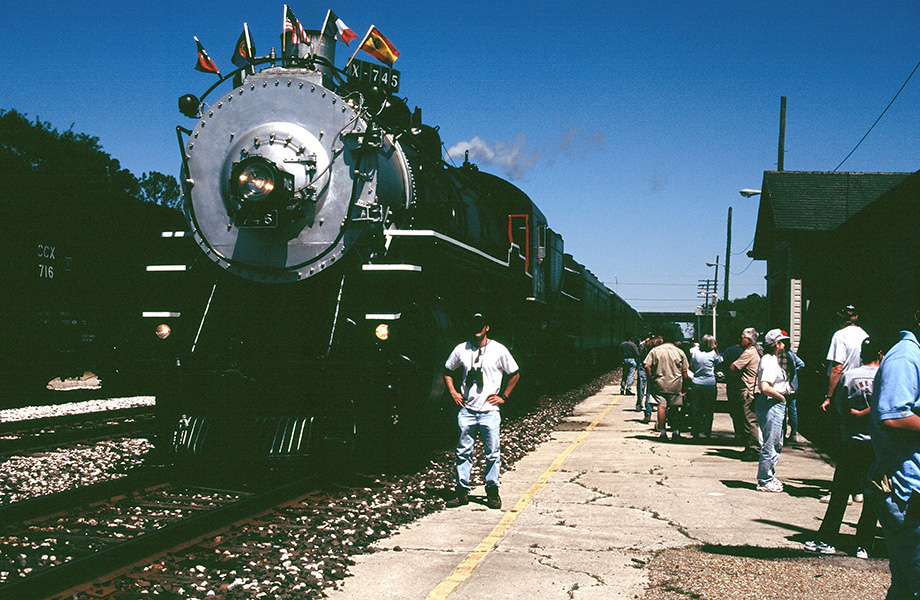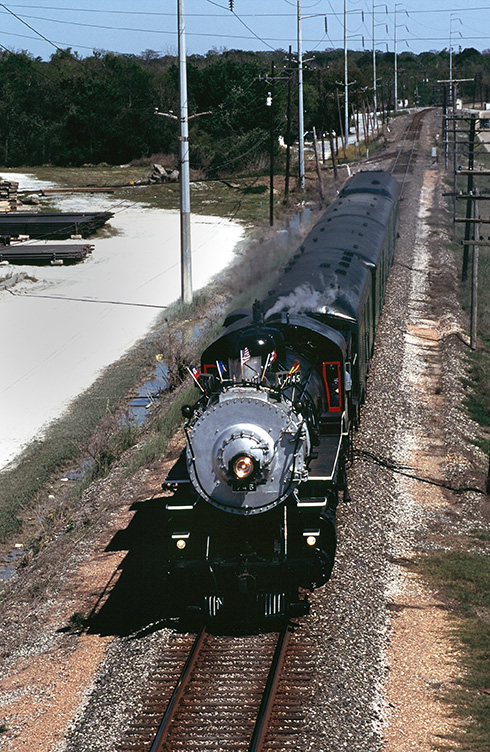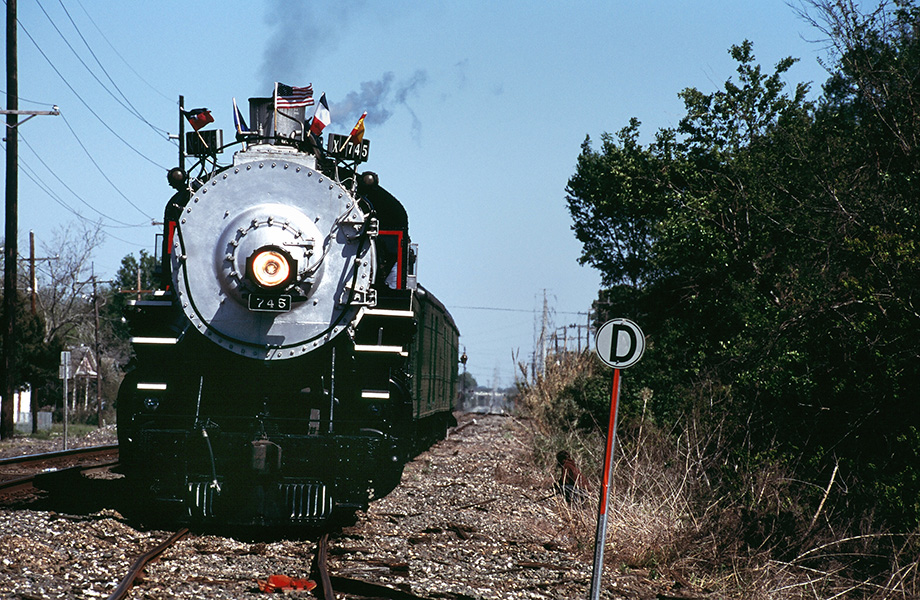This is a photo essay centered around four images that I made of the Southern Pacific 745 steam locomotive on its much-celebrated tour of the state of Louisiana in April 2005 shortly after it was restored to operating condition, but I have decided to broaden it into a description of the state of that momentous time in my life and what it foreshadowed.
The previous time from this time period that I have scanned film images published is December 2004, when we had snow on Christmas Day and the SP 745 operated over the Kansas City Southern Railway near New Orleans.
Fast forward a few months, and the SP 745 was leading the Louisiana Steam Train Association’s Bicentennial Train along tracks across Louisiana and Mississippi, the latter, if I recall, due to the Union Pacific Railroad being uncooperative with the whole thing.
At the end of March of 2005, I was in the Washington, DC, area with a friend on a personal trip, a friend that I would lose to fascism. We left New Orleans on the Crescent on March 26. We rented an automobile and drove to the Atlantic Coast in Delaware, my first time being in that state, and then to places like Monticello, the Manassas battlefield, and Montpelier, as well as spending plenty of time in Washington itself.
Going to the D.C. area in late-March and early-April was certainly different than being there in late-January and early-February. I really love Monticello, and the Virginia countryside is beautiful.
As I told an older friend, Howard, in California at time, after that trip, I would be mentally and intellectually ready to come to California! I didn’t want to see the Pacific Ocean before I saw the Atlantic Ocean. He and I had talked about me going to California to visit him, which I would do in September during the break caused by the devastation of Hurricane Katrina.
I had applied for a workshop in The Netherlands with the National Endowment For the Humanities.
The most major story going on in my life at the time was an attempt – that turned out to be successful – to get a good job in the metropolitan New Orleans area and move there. This would alter the course of my life, changing who I am and how I think.
As I type this essay 20 years after the time period that is the subject of this essay, I do not own a film scanner. So, the only images that I have here are ones that I paid a photography studio to scan a long time ago, and the images are from only the SP 745 chase that first weekend of April, which may be in part due to the fact that my camera at the time was failing, and most slides were not properly exposed, which led to my decision a few months later to finally go digital.
So, that’s the story here.
April 1st
My friend and I got back from the Potomac Valley on this night, and I got home around 21:30. I had forgotten how much I hate flying! It’s not the actual flying part that I don’t like; it’s all of the other crap.
I told my friend in California that something happened on the trip to D.C. that made me think more of going see him in California and that I would describe that later, but I don’t remember what that was!
I did learn on this night when I checked e-mail that I indeed had been selected to participate in a week-long teacher workshop in Dearborn, Michigan, entitled America’s Industrial Revolution. This, I thought, will be great, and I will get to add yet another state to the list of states to which I have been. (I had added two – South Carolina and Delaware – just in the past week!)
Saturday, The 2nd
I was really tired by this night! I spent much of this beautiful early spring day today chasing the SP 745 and the Louisiana Bicentennial Train. For the first time since I was five years old, a real steam locomotive passed through my homeland railroad. I got some pictures. Just about every local railroad enthusiast was out there.
Here is a picture made of me with my camera in front of the train at a very special place for me.
The last time that a steam locomotive had passed on these tracks was June of 1984 for the 1984 World’s Fair in New Orleans when the Southern Pacific ran its Daylight train pulled by the Southern Pacific’s steam-powered 4449 locomotive to and from New Orleans as part of the festivities.
This weekend’s Bicentennial Train was pulled by the recently restored Southern Pacific 745, a steam locomotive built in February 1921 by the SP at its shop in Algiers, and one of the very few steam locomotives to escape the fate of the scrap heap.
In previous years, attempts were made to restore the 745 to operating condition, but various organizations involved found it difficult to raise the funds needed for the project. By this time, the 745 had fallen victim to weathering and vandalism. The Louisiana Railway Heritage Trust had acquired the locomotive and moved it in October 1984 to its current home across Jefferson Highway from Ochsner Hospital.
In 1997, the Louisiana Steam Train Association acquired the locomotive with intention of restoring it to operating condition. At first, many railroad enthusiasts and observers were skeptical, given the previous failed attempts at finding funding and organizing support. However, LASTA obtained federal funding with the help of the state of Louisiana and Jefferson Parish, and restoration work commenced in late 2002.
LASTA intended to have the 745 operational in late 2003 in time to coincide with the bicentennial of the Louisiana Purchase, but funding delays and mechanical problems prevented this from happening.
For the first time in a half-century, despite the odds, the 745 moved under its own power in December of 2004 on the Kansas City Southern railroad in New Orleans for some break-in runs. The successful break-in runs helped convince some other major railroads in Louisiana, including the Burlington Northern Santa Fe Railway, which acquired the Southern Pacific mainline through the tri-parish area in 1995, to allow the Bicentennial Train to operate on their rails.
The chase of this train from Schriever to Morgan City was perhaps the most stressful chase of a train in which I have been involved. There were plenty of people, I am accustomed to the act of chasing trains being a solo activity, and someone either representing or closely affiliated with LASTA was pacing the train in an automobile, which made getting ahead of the train even more difficult.
Shawn Levy followed me to Morgan City, where I got this shot and, I guess, he got a similar shot.
That may be the first time that I did that shot. I don’t know.
Finally, I got the train coming to a stop at the runaround track in Morgan City.
This was a heck of a way to spend a day after I had just returned from a week of traveling in the Potomac Valley area.
Sunday, The 3rd
The next morning, I returned to Morgan City, and I photographed the train on the loop track in the morning light.

I then chased the train to New Iberia.
I got to Baldwin only in time to photograph from a church south on the highway as the train left town. The only place where I talked to and mingled with people was at New Iberia. It was good to see and talk to Perry, Joey, and Paul, especially since I hadn’t seen the latter two since November 2002 at the foamer-fest in New Iberia!
Anyway, the people of New Iberia were amazed and awed, including a woman who lives right in the curve of the beginning of the Midland Branch who talked about growing up with the Southern Pacific.
Epilogue
I did get a slot the NEH-funded workshop in The Netherlands and in England. I did, however, get a slot in an NEH-funded workshop in Massachusetts that was scheduled the week prior to the workshop in Michigan, and, with the KCSHS convention in Sallisaw, Oklahoma, along with my efforts to get a job at “The Jeff”, my summer had taken shape.
In June, the stars finally aligned, and The Cajun Porkchop and I finally met in a trackside encounter. As I type this two decades later, he remains a friend.
At around that time, I realized that my film camera had crapped out and needed to be repaired right before I was to take my big trip to the Northeast. I made the decision then that this was the time to finally “go digital”, something that I soon wished that I had done earlier, but what complicated matters is that this also meant that I needed to buy a new computer, which I did.
Then came Hurricane Katrina, what was, for me, a dubiously-timed catastrophe that altered my life just as the other change that I had enacted just before it struck did. This would lead to more travel before the year ended.
This was such a momentous time for me, and the continuity of this photo story will be maintained when I begin writing “Sampler” essays for each month in 2005 and for a few years afterward starting in a few months.
Please stay tuned for that, and thank you for your readership.
Merci,
Jim



